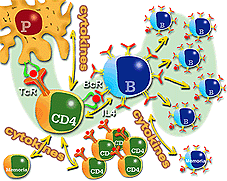|
|||||
|
|
HOW ARE LYMPHOCYTES ACTIVATED?
|
||||
|
|||||
|
|
HOW ARE LYMPHOCYTES ACTIVATED?
|
||||
|
Cytokines have a role in the activation and differentiation of T and B lymphocytes, in the regulation of the number of lymphocytes needed at a given time and in the length of their half-life. This includes the memory lymphocytes. Cytokines modulate the main activities of these important cells of the immune system. |
||||||||||||||||||||||||||||||||||||||||||
|
We studied in previous chapters about cell cooperation in the immune response. The activation of T and B lymphocytes takes place through a series of processes in which, in addition to lymphocytes, antigen presenting cells and antigens have a role. Cytokines also participate in this important process of the adaptive immune response. They do so by enhancing the activation of T and B lymphocytes. Two different signals are necessary for the activation of T lymphocytes, and their entrance into the G1 phase of the cell cycle. The first signal comes from the interaction with the antigen, and the other is a co-stimulatory signal. |

Diagram of the cell cooperation in the adaptive immune response. Cytokines play an important role in these processes. |
|||||||||||||||||||||||||||||||||||||||||
|
The IL2 cytokine is secreted as a consequence of this stimulation. This allows the proliferation and differentiation of T lymphocytes in the following cellular subtypes of helper T lymphocytes CD 4+ (T helper): Th 1 lymphocytes (T helper 1) and Th 2 lymphocytes (T helper 2). Both populations of lymphocytes produce different sets of cytokines. |
||||||||||||||||||||||||||||||||||||||||||
|
Lymphocytes Th 1. They are mainly related to macrophage activation in processes of elimination of intracellular antigens (phagocytosis activation) and in the activation of NK cells, inducing cytotoxicity in the infected cells. They also produce pro-inflammatory cytokines as a response to an antigenic stimulation. |
These cytokines promote the differentiation of
cytotoxic effectors. The most important are:
|
|||||||||||||||||||||||||||||||||||||||||
|
Lymphocytes Th 2. They are related to activation and differentiation of B lymphocytes. Th 2 lymphocytes recognize the antigen located on the surface of B lymphocytes, along with the SLA-II molecules, and then induce the clonal expansion of B cells and, as a consequence, their differentiation into plasma cells, which produce antibodies. The Th 2 also participate in the activation of eosinophils.
The most important cytokines secreted by these cells are:
In addition to these two sub-types of helper lymphocytes (Th 1 and Th 2), there is another helper lymphocyte known as Th 0. This seems to be related to an intermediate process of differentiation between Th 1 and Th 2. Th 0 can secrete cytokines belonging to both cell groups (Th 1 and Th 2). |
B lymphocytes activation |
|||||||||||||||||||||||||||||||||||||||||
|
There are no clones of helper lymphocytes with restricted patterns of cytokines in the porcine species, but immune responses that are mainly Th 1 or Th 2 have been already described. In regard to CD8+ lymphocytes (which are mainly cytotoxic lymphocytes) it is known that they secrete cytokines of the types of Interferon (IFN-g) and Tumor Necrosis Factor (TNF-b). These cytokines activate cytotoxic mechanisms in macrophages and granulocytes; thus they have a Tc1 pattern, similar to that of the Th 1. |
||||||||||||||||||||||||||||||||||||||||||
|
||||||||||||||||||||||||||||||||||||||||||
|
How are cytokines studied?
The study of cytokines presents several problems. Some of them are due to their own characteristics, such as low concentrations, short half lives, and the redundancies in their biological effects. All this makes their study difficult.There are also other problems related to the lack of available reagents for their study, with the exception of the murine and human species. This last problem, thanks to the recombinant cytokines, is gradually being solved.
The methods most frequently used are:
|
||||||||||||||||||||||||||||||||||||||||||
|
Immune methods. The newly obtained recombinant cytokines have allowed the production of monoclonal antibodies and the development of different methods for the assessment of several cytokines.These methods, most of them immune-enzymatic as is the ELISA, are highly sensitive and specific for the assessment and quantification of cytokines. However, they have a problem: they are not able to detect those cytokines that are not biologically active.
Diagram of the production of monoclonal antibodies. |
Molecular methods. They have been developed thanks to the study of the different sequences of a great number of cytokines, which has allowed the use of the amplification techniques (PCR). This allows the detection of cytokines in different cells and tissues. These techniques, that may also be quantitative techniques, can detect and quantify cytokines as in the case of the immunological techniques. Their detection does not always mean that they have biological activity however.
PCR gel |
|||||||||||||||||||||||||||||||||||||||||
|
Even though the porcine species is very important as a transplantation model, with its potential for xenografts, and as farm animals, the study of porcine cytokines presents several problems. On the one hand, there are not many cloned cytokines, especially when compared with other species.
On the other hand, the number of available reagents for the study of the function and regulation of cytokines is very small. The number of recombinant cytokines is still low, and there are not many commercially available; this limits the production of monoclonal antibodies Currently, the best option for the study of porcine cytokines is the use of the molecular techniques (quantitative PCR). |
||||||||||||||||||||||||||||||||||||||||||
| CHAPTER 6 | Previous theme | Bibliography | Course program |